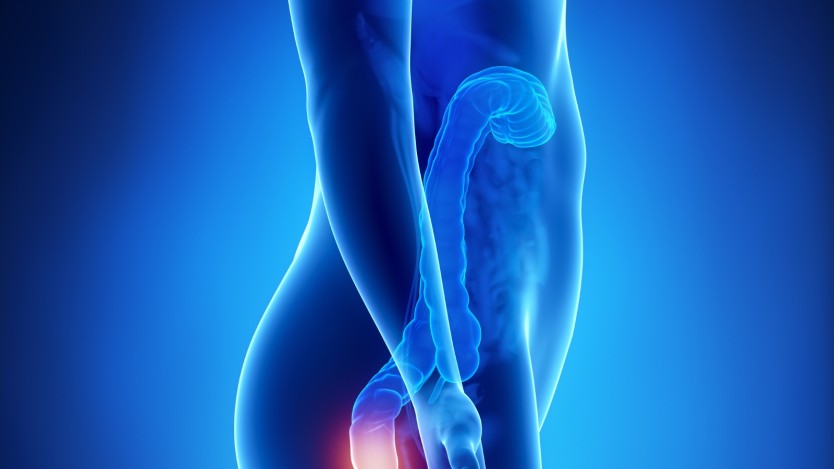Sphincterotomy: anal fissure repair

- Sphincterotomy is the surgical repair of an anal fissure.
- In addition to sphincterotomy, there are other types of treatment to repair an anal fissure, but they are not as effective.
- If the anal fissure is chronic, the best option for anal fissure repair is surgery.
What is an anal fissure?
An anal fissure is the tearing or partial rupture of part of the tissue surrounding the external orifice of the digestive tract, which we call the anus. The tissue surrounding the anus is a mucous tissue, much weaker than the surrounding skin, it has a more congestive appearance (the mucosa appears a little more inflamed and darker in colour), it is red or purplish in colour and is easily broken.

Do you need anal fissure surgery?
Request a free and immediate appointment with our specialists in General Surgery
Anal fissures usually occur in the posterior part of the anus in both men and women in 90% of cases and mainly involve a high contraction of the internal anal sphincter (muscle that surrounds the rectum, the urethra and the uterus and vagina in women, allowing voluntary urination and defecation in humans depending on whether it contracts or relaxes).
Anal fissures can be classified in 2 different ways, although the most internationally adopted classification is according to the form of appearance of the anal fissure. If the onset of anal fissure is less than 8 weeks and we have never had an anal fissure before, at least in the last 2 years, this pathology will be considered acute. However, if we habitually suffer from anal fissures always in the same location or if the fissure lasts more than 8 weeks despite conservative medical treatment, we can speak of chronic anal fissures.

How is an anal fissure repair performed?
The definitive solution for the treatment of anal fissures, especially those of a chronic nature, is the surgical intervention known as lateral internal sphincterotomy. In any case, when we talk about the treatment of anal fissures, both acute and chronic, we find different therapeutic options that can basically be grouped into two large differentiated blocks that are currently directed towards one of the two types of anal fissure mentioned above.
Thus, we can divide the treatment of an anal fissure into two main options:
Acute anal fissure treatment
The treatment of an acute anal fissure is mainly dietary and medical, which is why this type of therapeutic option is generally chosen in the event of an anal fissure lasting less than 8 weeks.
The aim of this treatment is to try to hydrate the faeces by ingesting water and fibre so that no great abdominal pressure is necessary for defecation and, on the other hand, to relax the internal anal sphincter, which is what hinders the resolution and healing of the anal fissure, causing it to become chronic and last for a long time.
We can therefore define the following compounds as candidates for this type of treatment:
- Abundant intake of water and dietary fibre: abundant intake of water and fibre keeps stools less compact and hard, thus preventing constipation. This intestinal dysfunction is the cause of the increased abdominal pressure in patients who suffer from it, which leads to an increase in the internal sphincter of the anus, chronifying the anal fissure. The friction caused by the passage of faeces through the anal canal and anus is a common source of reopening of fissures in the process of healing.
- Sitz baths: Sitz baths with warm water of the perineal region 1-2 times a day for 10 minutes is one of the most studied recommendations and is an effective additional treatment for the resolution of anal fissures. Warm or hot sitz baths reduce the exaggerated contraction of the internal anal sphincter, thereby improving the chances of anal fissure resolution. The combination of water + fibre + sitz baths has been shown to be more effective than treatment with topical nitroglycerin and topical corticosteroids.
- Topical nitroglycerine and topical corticosteroids: the use of medicinal substances that, due to their mechanism of action, achieve relaxation of the internal anal sphincter has been classically promoted. The use of topical corticosteroids and nitroglycerin has been losing medical value in recent years as a result of the appearance of new studies that question their virtues in improving anal fissures. They are now considered second choice drugs for chronic and acute anal fissures.

Treatment of chronic anal fissure
As mentioned above, chronic anal fissures are those that remain active for at least 8 weeks from the beginning and do not respond to medical treatment. Within this type of anal fissure, surgical treatment by means of sphincterotomy is the most recommended, although there are currently other therapeutic options, without proven efficacy at the present time.
Among the surgical possibilities, there is one technique that emerges as the standard gold among the others: lateral internal sphincterotomy.
Lateral internal sphincterotomy
This is the surgical technique by which the surgeon makes a cut in the outermost fibres of the internal and lateral portion of the anal sphincter.
The aim of this intervention is to reduce the contraction of the internal sphincter and improve the scarce vascularisation that reaches the anal fissure due to the sphincteric contraction itself, which is the cause of the difficulty in closing anal fissures.
To do this, the surgeon must dilate the anus using a bivalve anal retractor to expose the fissure to the specialist surgeon. Once the surgeon has a complete view of the fissure, he proceeds to locate the intersphincteric groove that marks the division between the internal portion of the anal sphincter and its external portion.
After locating this region, a minimal incision is made with a scalpel or electric scalpel no larger than 2-4 mm in the region of the internal lateral sphincter and then sutured. This surgical technique has gained an advantage over others because of its short hospital stay (1-2 days), immediate improvement of symptoms, a small number of complications and a recurrence of the fissure in less than 8 months in less than 2% of cases.
Botulinum toxin
This relatively modern technique, recommended in certain specific cases, is considered a second-line intervention. The administration of botulinum toxin, as opposed to sphincterotomy, consists of the administration by injection of a chemical substance known as botulinum toxin (a product with other medical and surgical indications) which is capable of blocking different receptors in the muscle fibres of the internal sphincter, preventing their contraction.
With this technique, it is possible to maintain partial flaccidity of this portion of the sphincter for a maximum of 3 months, although there is currently no scientific consensus on the doses and site of infiltration. The anal fissure healing rate is around 60-80%, but a certain level of faecal incontinence and gas may be observed in 10% of patients during this period. The main advantage of this technique lies in the simplicity of the procedure as it is an outpatient procedure and does not require anaesthesia or hospitalisation.

Do you need anal fissure surgery?
Request a free and immediate appointment with our specialists in General Surgery
Medical disclaimer: All the published content in Operarme is intended to disseminate reliable medical information to the general public, and is reviewed by healthcare professionals. In any case should this information be used to perform a diagnosis, indicate a treatment, or replace the medical assessment of a professional in a face to face consultation. Find more information in the links below:
